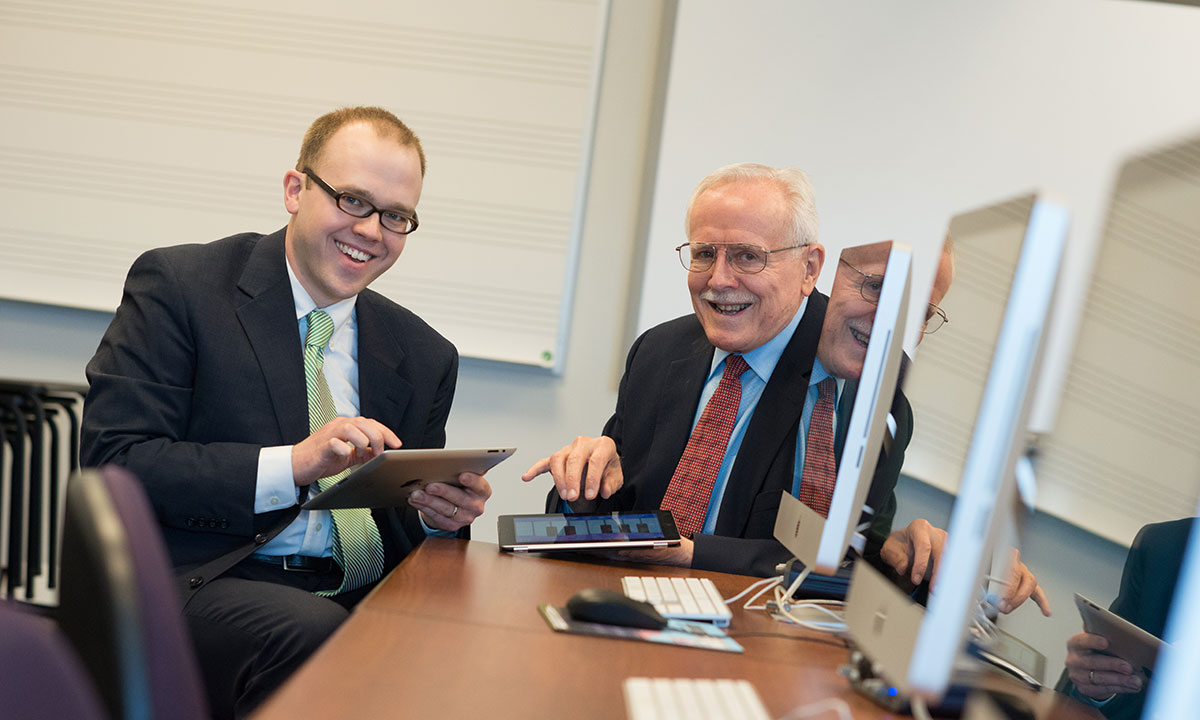Ageless music and technology
News
Undergraduate students waiting anxiously behind their computers was the scene that greeted Dr. David Stringham as he entered the Mac computer lab in the Forbes Center to teach the fall 2011 semester’s Introduction to Technological Applications in Music class. Before the assistant professor began that first class by asking students to share about themselves and their perspectives on technology, Stringham knew he had a standout, based on appearance alone.
“Paul Ackerman was a special student in my class,” says Stringham, recalling the retired government worker in his late 70s who has a passion for playing music and appreciating its therapeutic value from his education in special education and child psychology – he holds a Ph.D. in the discipline – and his experience in such roles as director of the National Institute on Disability and Rehabilitation Services of the U.S. Department of Education. Plus, there was an apparent technological generational gap between Ackerman, his classmates and Stringham himself, which gave Ackerman pause.
Non-digital native Ackerman overcame the challenge of working with evolving technology in Stringham’s course by spending approximately five to six extra hours with the software Stringham used in class. Ackerman says, “Music technology is usually seen as something freshmen have to take, but it’s more than that – it’s used in things like the recording industry or for personal use. It allows you to digitally relax.”
As Ackerman overcame the generational digital divide and explored more applications, he and Stringham wondered about the possible impacts of music technology on other senior adults. The two collaborated in areas of their expertise: Stringham with his background in music, learning and teaching, and technology and Ackerman with a background in music therapy. They devised a research survey to understand how seniors in the Shenandoah Valley region might wish to engage with music and/or music technology. Their findings, “Another New Horizon? Music technology for senior adults,” were published in the International Journal of Community Music, and revealed that among their sample of seniors 65 years and older, participants were strongly influenced by music in their life, but had little interest in using computers. Stringham and Ackerman described their process for creating a music technology course for senior adults, offering opportunities for musical growth, personal expression and social interaction.
In spring 2013, Ackerman and Stringham collaborated with two JMU undergraduate music major teaching assistants to facilitate their first music technology class through JMU’s Lifelong Learning Institute. Most of the five adult students enrolled in the class had either a background in music or a passion for music appreciation throughout their lives. Instructors introduced a wide range of programs, many of which were used to manipulate, create and share music. Class members learned about Vimeo, iTunes, Singsnap, Mixcraft, Facebook and more.
The two instructors utilized innovative, yet simple technologies for their students to compose unique music in class. Stringham held a portable yellow device called a kaossilator, which produced electronic drumbeats and synth sounds. It allows a user to record a series of loops and layer sounds on top of one another. He glided his fingers across the device’s touch pad while adjusting pitch levels of each sound. As Stringham says, it offers “a new opportunity for learning and thinking musically.” Ackerman personally enjoyed teaching with the iPad since it felt realistic and is an ideal tool for elders with mobility issues. They taught a lesson on GarageBand where students were able to touch the iPad screen and produce music by strumming the guitar, beating drums or singing a song. Students of the class also enjoyed free music outlets such as iTunes Radio and Pandora.
Once the music and technology course ended in March, it became clear to Stringham and Ackerman that there is an endless list of future possibilities for incorporating music technology into senior citizens’ everyday lives. Stringham and Ackerman are intrigued with the idea of extending their LLI-based course to other communities of older adults. There is an opportunity to integrate music and technology with other professions such as music therapy and social work in settings such as nursing homes or retirement communities and even for family members to engage in the pleasure of music creation and listening.
The supposedly retired Ackerman has no plans to slow down as he finds himself busy teaching a Music and Human Services course to undergraduates as an adjunct faculty member, which he will teach again in fall 2013. He is even contemplating starting his own iPad band. Ackerman and the five senior students demonstrated that it is possible to bridge the technological gap with numerous beneficial outcomes.
Stringham says, “It’s been inspiring to see an almost-80-year-old seek out—and embrace—new musical experiences with technology.” While Ackerman feels renewed, thanks to mastering today’s technology, he also feels a sense of reward teaching peers his own age, watching them grow and develop the same language and understanding of this concept by the end of the class.
“New perspectives are opening to me,” Ackerman said, “I would not have thought of this idea unless I took this course and experienced it myself. However, I would not have carried it further unless David had been as interested, helpful and suggestive.”
# # #
By Stephanie Strickland (’13), JMU Public Affairs
July 1, 2013

